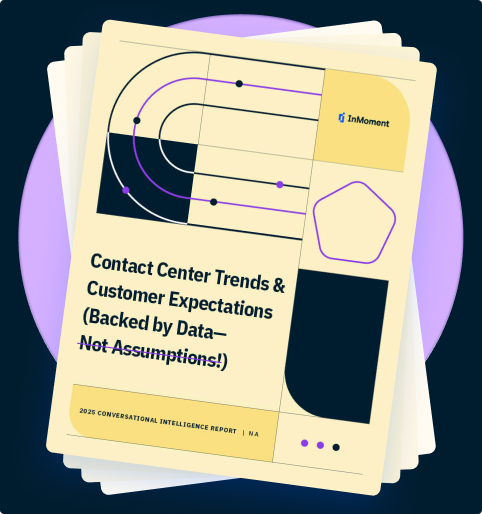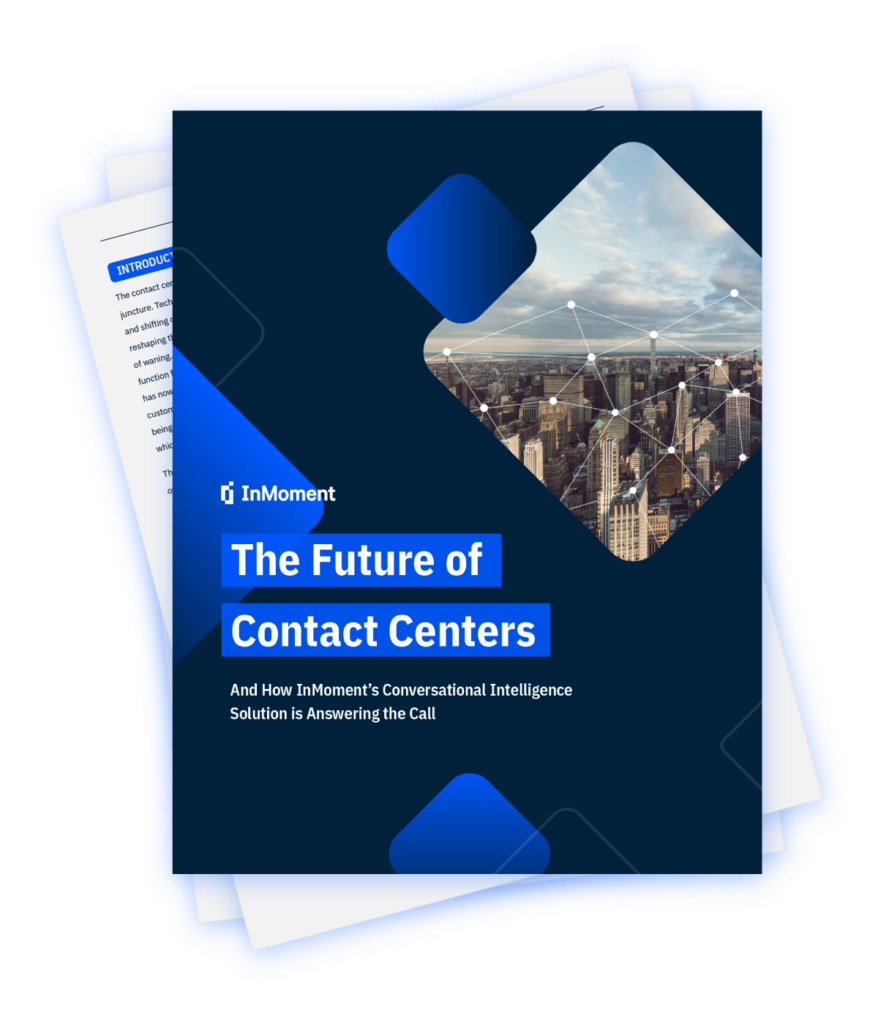Conversational Intelligence for Insurance: Transforming Claims, Compliance, and Customer Experience
Learn how conversational intelligence transforms insurance operations—enhancing CX, accelerating claims, and navigating regulatory compliance.
From geopolitical instability to a shifting regulatory landscape, the insurance industry is experiencing significant transformation. These massive shifts, combined with rising policyholder expectations for smooth and personalized service, require a data-driven approach to providing insurance.
Conversational Intelligence (CI) is emerging as a game-changer in this space. It leverages artificial intelligence to analyze agent-customer interactions, streamline workflows, and improve outcomes across claims, service, and compliance.
Benefits of conversational intelligence for insurance providers
With the insurance industry navigating growing expectations and complexity, the need for efficient and personalized services is greater than ever. Here are four major ways in which CI improves account health for insurance providers.
Faster, more accurate claims processing
Delays in claims processing erode customer trust and drain resources. Conversational intelligence helps by analyzing automated call summaries to flag common issues, uncover friction in workflows, and guide agents toward smoother resolution.
For example, if multiple policyholders are confused about required documentation, conversational AI technology surfaces those patterns across channels. This allows insurers to clarify policy details, reduce wait times, and even automate repetitive tasks like follow-up reminders. As a result, the claims process is more efficient and consistent.
Improved customer experience and personalization
Policyholders expect empathy and transparency when interacting with their insurer. With AI-driven insights, insurance companies are better able to identify unique customer needs, concerns, and preferences.
CI also supports effective location-based campaigns by highlighting how policyholders respond in different regions. This information is useful for delivering tailored communication across the entire customer journey. Customers feel heard and valued, which is key for retention and satisfaction.
Agent coaching and performance optimization
Even top-performing agents require targeted coaching to put their best foot forward. CI helps achieve this goal by giving supervisors visibility into agent behavior. It surfaces patterns from customer queries, tone, and resolution quality.
Unlike manual review, the automated nature of CI allows managers to evaluate 100% of agent-customer interactions without breaking a sweat! As a result, contact center leaders can use real call data to monitor human agent behavior, pinpoint best practices, and identify areas for improvement.
Better compliance monitoring and risk reduction
Organizations are increasingly keen on evolving their compliance programs to avoid penalties and reputational damage. According to Drata’s 2023 Compliance Trends Report, 87% of organizations indicated negative outcomes due to low compliance maturity. With the insurance business being such a heavily regulated space, insurers are under immense pressure to comply.
The ability of CI to automatically monitor and record conversations across channels is invaluable here. Besides tracking 100% of conversations for audit purposes, it helps ensure regulatory adherence by detecting missed disclosures and suspicious agent behavior.
Therefore, compliance and QA teams no longer need to manually review every interaction. Instead, they can focus their efforts where the risk is highest, significantly improving risk management and ensuring that the entire organization remains audit-ready.
Key use cases of conversational intelligence in insurance
The ability to analyze customer interactions at scale is crucial for improving policyholder experiences and internal operations. The following use cases show how CI helps insurance providers deliver proactive and personalized service across the entire customer journey.
Claims management and fraud detection
Few processes are as critical in the insurance industry as claims processing. Delays, miscommunication, or oversight at this stage result in lost trust, increased operational costs, and reputational damage. CI equips insurance providers with the tools to analyze claims-related conversations in real-time, helping them accelerate resolutions while also detecting potential fraud.
The tool uses natural language processing (NLP) to sift through thousands of call transcripts and identify patterns in claim inquiries. For instance, if it spots inconsistencies across different policyholder accounts, it flags them for further review. This feature is key for early fraud detection without requiring exhaustive manual analysis.
Beyond fraud, CI tools help streamline the claims journey by identifying common pain points. They highlight instances of frustration and confusion amongst policyholders, so that insurers can adjust their scripts or update internal workflows for more efficient service.
Enhancing call center operations
Modern contact centers in the insurance sector handle an overwhelming volume of inquiries, from simple policy questions to complex claims. With rising expectations for speed and accuracy, operational performance can’t be left to guesswork.
Conversational AI helps by analyzing every interaction, uncovering performance trends, and supporting informed decision-making. For instance, it processes call summaries in real-time to surface actionable insights like recurring complaints, long silences, or script deviations. This information helps leaders understand why calls take longer to resolve or which agents require additional coaching.
CI also supports smarter staffing decisions by revealing call volume patterns and common call categories. The result is a more responsive and efficient operation that reduces wait times, improves consistency, and allows teams to focus on high-value engagements.
Improving customer onboarding and policy renewals
The first impression sets the tone for the entire customer journey. Additionally, policy renewals are a make-or-break moment for retention. CI improves both processes by equipping insurance providers with instant insight into friction points, common complaints, and missed opportunities for customer engagement.
For example, if many policyholders ask the same questions about coverage limits or pricing during onboarding, CI surfaces those trends for contact center teams. Agents and managers are then able to optimize scripts, educational content, and self-service flows. During renewals, the tool can help by flagging sentiment shifts in real time. This allows agents to address concerns proactively before a policy lapses.
Boosting compliance and QA processes
Ensuring regulatory compliance across high-volume customer interactions is both critical and resource-intensive. Conversational AI platforms help through continuous call monitoring and analysis. These processes are key for detecting missed disclosures or suspicious agent behavior.
QA teams benefit from CI through automatic analysis of each agent-customer interaction. This ensures regulatory accuracy, improves agent consistency, and drastically reduces the effort and cost of manual review. It also supports audit readiness, helping insurers stay aligned with industry standards without sacrificing operational efficiency.
Identifying customer sentiment and service gaps
Understanding how policyholders feel is essential to delivering standout service. CI leverages sentiment analysis to track tone, emotion, and intent in real-time across all customer queries and channels like chatbots and social media.
This enables insurers to detect cases of confusion, frustration, or disengagement among customers. These emotional signals highlight emerging service gaps, so that teams can prioritize follow-up and refine customer support strategies for better outcomes.
Automating how calls are categorized
Accurate conversation tagging is essential for tracking issue trends, reporting, and process improvement. But manual categorization is time-consuming and often inconsistent.
Conversational AI removes this friction by automatically detecting intent and applying relevant categories to every interaction. For instance, InMoment’s CI tool uses machine learning to auto-detect customer intent and apply the right category in real time. This automation reduces repetitive tasks for agents and ensures consistent data collection for QA, product, and operations teams.
Identifying and resolving root cause behind issues
Surface-level issues like repeated customer support calls or frequent clarifications on insurance policy terms often point to deeper problems. CI helps uncover the root cause by aggregating and analyzing interaction data across every communication channel.
By connecting these dots, insurers can detect recurring breakdowns in communication, process bottlenecks, or knowledge gaps that drive dissatisfaction. These CI insights empower teams to take strategic action, including agent training and removing operational bottlenecks. The result is a smoother customer experience and long-term cost savings.
Steps for implementing conversational intelligence in insurance
Integrating CI into your daily operations involves more than just investing in the tool. It requires a strategic rollout, from identifying your goals to training your team. Here are four key steps for leveraging CI to transform conversations into actionable insights.
1. Identify use cases and goals
The first step towards successful conversational AI implementation is knowing exactly where it can deliver the most value. For insurance providers, this means identifying the high-impact customer interactions or internal workflows that would benefit most from CI insights.
Start by involving key stakeholders and aligning on mission-critical outcomes. These objectives could include increasing customer satisfaction, reducing claims processing times, or boosting compliance.
The next step is to identify corresponding use cases where CI can play a key role. For example, InMoment’s conversation analytics platform helps reduce legal exposure by automatically monitoring conversations for missed disclosures.
2. Choose the right conversational intelligence platform
Choose a platform that goes beyond the technology to assist you with professional services, including data collection, analysis, and selecting the right metrics to track.
As a leader in customer experience and conversational intelligence, InMoment helps large insurance providers turn unstructured data into action. Its conversational AI platform offers:
- Accurate transcription and NLP tailored for industry-specific terminology
- Multilingual support for diverse policyholder bases
- Built-in data security and compliance features to protect sensitive customer data
- Seamless integration with existing CRM, claims management systems, and contact center tools
- Omnichannel capabilities to unify conversations across voice, chat, email, and apps
These features help surface opportunities to improve service quality, reduce risk, and boost operational agility at scale. As a result, you can simplify decision-making and drive positive customer experience outcomes by working with a proven partner.
3. Integrate with existing systems
CI delivers maximum value when it works in concert with your existing technology stack. Seamless integration with tools like CRM platforms and claims management systems enables CI to analyze key datasets and provide valuable insights.
InMoment leverages robust CX integrations to enable the smooth flow of data across systems. These integrations empower teams to use shared insights and access a unified view of each policyholder’s history and preferences. By eliminating information silos, integrations allow for smoother experience management.
4. Train teams and set usage guidelines
Train your customer support agents and managers on how to make the most of conversational AI features. Besides enhancing adoption across teams, this step is key for ensuring consistent value for policyholders.
When teams understand how to track metrics, analyze automated call summaries, and trigger post-call surveys, they are better able to adopt a proactive approach to work. Similarly, managers can improve their coaching programs and ensure compliance by learning how to interpret customer interactions.
It’s also crucial to establish clear usage guidelines for your CI tool. This practice ensures teams use the tool responsibly and consistently. As a result, you can integrate AI into daily operations without compromising the human touch that customers value the most.
Drive performance and progress with InMoment’s Conversational Intelligence
From faster claims processing to surfacing opportunities for agent improvement, CI is key for gaining a competitive advantage in the insurance industry. It turns everyday interactions into strategic insight, enabling insurers to meet the rising expectations of modern policyholders.
InMoment empowers insurance providers with comprehensive data analysis, automated QA and compliance review, and reliable fraud detection. Beyond the cutting-edge technology, you get access to a professional team of CX experts when you partner with us. From building custom datasets to selecting the right metrics to track, we set you up for long-term operational and customer success.
Schedule a demo today to see how you can modernize your insurance operations with AI-powered insights!
















